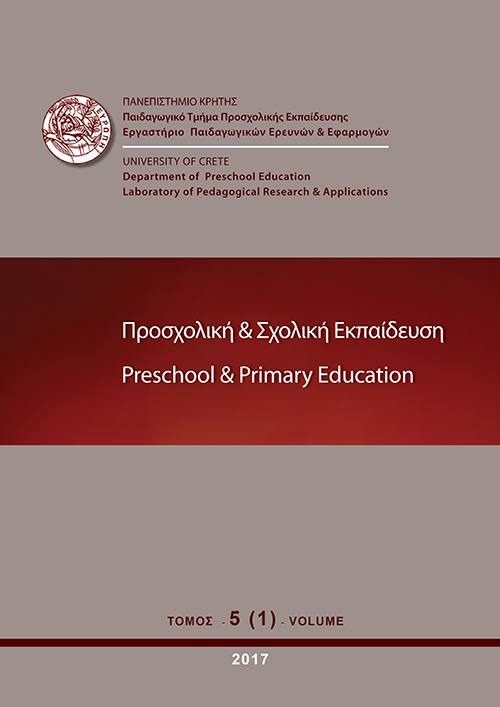Η κατανόηση των μαθηματικών μοτίβων από παιδιά Γ’ και Δ’ δημοτικού και οι στρατηγικές σκέψης τους

Περίληψη
Σκοπός της παρούσας έρευνας είναι η μελέτη του τρόπου με τον οποίο τα παιδιά των μεσαίων τάξεων δημοτικού σχολείου αντιλαμβάνονται και επεκτείνουν μαθηματικά μοτίβα. Για τον σκοπό αυτό, πραγματοποιήθηκε έρευνα σε 48 παιδιά της Γ’ τάξης και 42 παιδιά της Δ’ τάξης, στα οποία παρουσιάστηκαν συνολικά 21 έργα. Τα έργα αφορούσαν δύο κύριες κατηγορίες μοτίβων (οπτικά και αριθμητικά μοτίβα), οι οποίες χωρίζονταν επιμέρους σε: α) επαναλαμβανόμενα οπτικά και αριθμητικά μοτίβα, και β) αναπτυσσόμενα οπτικά και αριθμητικά μοτίβα. Οι συμμετέχοντες έπρεπε να μελετήσουν το μοτίβο σε κάθε έργο και να συμπληρώσουν το στοιχείο που λείπει κάθε φορά ώστε να ισχύει το μοτίβο. Επίσης, στο τελευταίο έργο ζητήθηκε από τους συμμετέχοντες να κατασκευάσουν οι ίδιοι ένα μοτίβο. Τα αποτελέσματα έδειξαν παρόμοιες αρκετά υψηλές επιδόσεις των συμμετεχόντων στα έργα με οπτικά και αριθμητικά μοτίβα. Ωστόσο, όλα τα παιδιά παρουσίασαν μεγαλύτερα ποσοστά επιτυχίας στα έργα με επαναλαμβανόμενα οπτικά και επαναλαμβανόμενα αριθμητικά μοτίβα σε σχέση με τα έργα που αναφέρονταν σε αναπτυσσόμενα οπτικά και αναπτυσσόμενα αριθμητικά μοτίβα. Η ανάλυση των στρατηγικών που τα παιδιά χρησιμοποίησαν στη συνέχιση των μοτίβων έδειξε ότι αυτές διαφοροποιούνται όταν τα μοτίβα είναι επαναλαμβανόμενα ή αναπτυσσόμενα. Συγκεκριμένα, τα παιδιά αιτιολόγησαν τις απαντήσεις τους κυρίως βασιζόμενα στη στρατηγική των συνδέσεων ανάμεσα σε διαδοχικά βήματα, όταν τα μοτίβα ήταν αναπτυσσόμενα, και πολύ λιγότερο σε μια τυχαία πρόβλεψη. Αντίθετα, όταν τα μοτίβα ήταν επαναλαμβανόμενα, τόσο στα οπτικά όσο και τα αριθμητικά μοτίβα, οι αιτιολογήσεις των παιδιών βασίζονταν κυρίως σε προβλέψεις που γίνονταν με επανάληψη μερών του μοτίβου. Τέλος, η πλειονότητα των συμμετεχόντων κατασκεύασε οπτικά επαναλαμβανόμενα μοτίβα, αναδεικνύοντας την προτίμησή τους σε αυτά.
Λεπτομέρειες άρθρου
- Πώς να δημιουργήσετε Αναφορές
-
Desli, D., & Gaitaneri, D. (2017). Η κατανόηση των μαθηματικών μοτίβων από παιδιά Γ’ και Δ’ δημοτικού και οι στρατηγικές σκέψης τους. Preschool and Primary Education, 5(1), 63–83. https://doi.org/10.12681/ppej.10216
- Τεύχος
- Τόμ. 5 Αρ. 1 (2017)
- Ενότητα
- Άρθρα

Αυτή η εργασία είναι αδειοδοτημένη υπό το CC Αναφορά Δημιουργού – Μη Εμπορική Χρήση – Παρόμοια Διανομή 4.0.
Οι συγγραφείς των άρθρων που δημοσιεύονται στο ΠΡΟΣΧΟΛΙΚΗ & ΣΧΟΛΙΚΗ ΕΚΠΑΙΔΕΥΣΗ διατηρούν τα δικαιώματα πνευματικής ιδιοκτησίας επί των άρθρων τους, δίνοντας στο περιοδικό το δικαίωμα της πρώτης δημοσίευσης. Άρθρα που δημοσιεύονται στο ΠΡΟΣΧΟΛΙΚΗ & ΣΧΟΛΙΚΗ ΕΚΠΑΙΔΕΥΣΗ διατίθενται με άδεια Creative Commons 3.0 και σύμφωνα με την άδεια μπορούν να χρησιμοποιούνται ελεύθερα, με αναφορά στο/στη συγγραφέα και στην πρώτη δημοσίευση για μη κερδοσκοπικούς σκοπούς και με δικαίωμα τροποποίησης μόνον με παρόμοια διανομή (αν αναμείξετε, τροποποιήσετε, ή δημιουργήσετε πάνω στο υλικό, πρέπει να διανείμετε τις δικές σας συνεισφορές υπό την ίδια άδεια όπως και το πρωτότυπο). To Εργαστήριο Παιδαγωγικών Ερευνών και Εφαρμογών του Παιδαγωγικού Τμήματος Προσχολικής Εκπαίδευσης του Πανεπιστημίου Κρήτης και το Εθνικό Κέντρο Τεκμηρίωσης διατηρούν το δικαίωμα να δημοσιεύουν, να αναπαραγάγουν, να παρουσιάζουν στο κοινό, να διανέμουν και χρησιμοποιούν άρθρα που δημοσιεύονται στο ΠΡΟΣΧΟΛΙΚΗ & ΣΧΟΛΙΚΗ ΕΚΠΑΙΔΕΥΣΗ σε οποιοδήποτε μέσο και μορφή είτε μεμονωμένα είτε ως μέρη συλλογικών έργων, για όλο το χρόνο διάρκειας προστασίας της πνευματικής ιδιοκτησίας και για όλες τις χώρες του κόσμου. Αυτό περιλαμβάνει ενδεικτικά και όχι αποκλειστικά, το δικαίωμα δημοσίευσης των άρθρων σε τεύχη του περιοδικού ΠΡΟΣΧΟΛΙΚΗ & ΣΧΟΛΙΚΗ ΕΚΠΑΙΔΕΥΣΗ, αναπαραγωγής και διανομής μεμονωμένων αντιγράφων των άρθρων, αναπαραγωγής ολόκληρων των άρθρων σε άλλη έκδοση του Εργαστηρίου Παιδαγωγικών Ερευνών και Εφαρμογών του Παιδαγωγικού Τμήματος Προσχολικής Εκπαίδευσης του Πανεπιστημίου Κρήτης και του Εθνικού Κέντρου Τεκμηρίωσης και αναπαραγωγής και διανομής των άρθρων ή περίληψης αυτών με χρήση πληροφορικού συστήματος αποθετηρίου.


